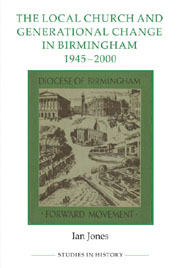Book contents
- Frontmatter
- Contents
- List of figures and tables
- Acknowledgements
- Abbreviations
- Map of Birmingham
- Introduction
- 1 Birmingham: the city and its churches
- 2 The spectre of ‘decline’
- 3 Church, youth and family from the 1940s to the 1960s
- 4 Life and worship in the local congregation
- 5 Church and neighbourhood: four congregational stories
- 6 Towards the margins: being Christian in a pluralist society
- Conclusion
- Appendix: Oral history
- Bibliography
- Index
Appendix: Oral history
Published online by Cambridge University Press: 05 February 2013
- Frontmatter
- Contents
- List of figures and tables
- Acknowledgements
- Abbreviations
- Map of Birmingham
- Introduction
- 1 Birmingham: the city and its churches
- 2 The spectre of ‘decline’
- 3 Church, youth and family from the 1940s to the 1960s
- 4 Life and worship in the local congregation
- 5 Church and neighbourhood: four congregational stories
- 6 Towards the margins: being Christian in a pluralist society
- Conclusion
- Appendix: Oral history
- Bibliography
- Index
Summary
In the following list of interviews, biographical details have been left deliberately basic in order to avoid identification of individuals and preserve the anonymity originally guaranteed to interviewees at the time of the research. Having experimented with giving the birth date and occupation of each interviewee, I tested (in confidence) a long-standing member of one of the case-study congregations to see if they could identify the speakers – 50 per cent of her guesses were correct. As a result, I have preferred to give a general socio-economic classification rather than specific job titles. This level of anonymity is comparatively rare in oral history but in this study the need to identify speakers with a particular congregation makes interviewees more easily identifiable than in most oral histories, where even full biographical details rarely reveal a person's identity. Giving anonymity to interviewees is quite standard practice in qualitative social research where the interview sample is drawn from an identifiable community. Any genuine researcher who wishes to know more about the sample for academic purposes is welcome to contact me.
Where two or more names are listed under the same entry, this indicates that they were interviewed together. Otherwise, all interviews were conducted on an individual basis. All names have been changed. In addition, interviews were conducted with five ordained clergy connected with the case-study churches, although this material has only been used as background for the study.
- Type
- Chapter
- Information
- Publisher: Boydell & BrewerPrint publication year: 2012

